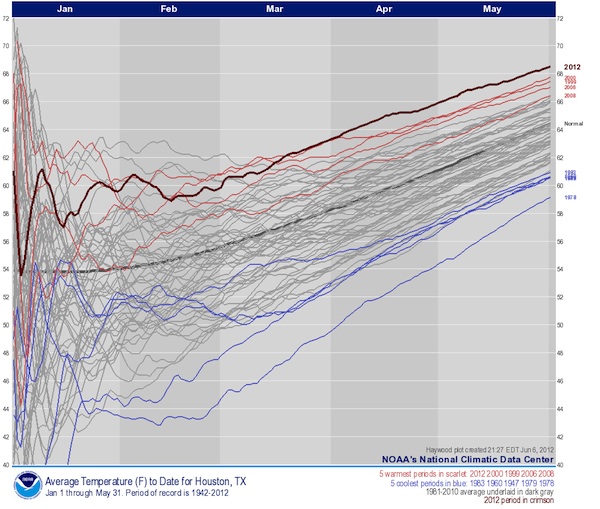Much of Texas has been getting something of a break from the history-making, headline-grabbing drought of 2011 in recent months, but the state’s excessive heat marches on.
All in all, temperature data through the end of May seem unlikely to be cited by many climate-change skeptics.
The figures, the NCDC reported, showed Texas had its warmest spring (March through May) on record and its third warmest January-through-May period.
Three Texas cities had their warmest January-through-May periods on record, while eight others on a list of 150 cities with long-term weather stations around the country were close to their warmest stretches for the first five months of a year.

The lines show Houston's average temperatures from January through May, 1942-2012. The dark red line represents 2012. The five warmest periods (in shades of red) were in 2012, 2000, 1999, 2006 and 2008.
Nationally, it was the warmest spring in the contiguous U.S. since 1895, January-through-May was the warmest such period ever, the 12 months that ended May 31 was the warmest consecutive 12 months ever, and last month was the second-warmest May.
Texas’ record average temperature this spring was 4.7 degrees above the seasonal average over 118 years of record keeping. (Last summer, the state’s average temperature was 5.3 degrees above average). The previous warmest spring in Texas was in 2006, when it was 4.3 degrees above average.
The state’s January-through-May average was 3.6 degrees warmer than the long-term average for the first five months of the year. The state’s warmest such period in 2000 was 4.1 degrees above average, while second-ranking 2006 was 3.8 degrees above average.
Adjoining states were also unusually warm. Arkansas Louisiana and Oklahoma had their warmest spring and warmest January-through-May periods, while New Mexico’s spring was its third-warmest and its January-through-May was its warmest initial five months of a year.
The three Texas cities that had their warmest January-through-May periods, along with then number of years for which records have been kept at those respective weather stations, were Amarillo (71 years), Houston (64 years) and Lubbock (66 years).
Other Texas cities had unusually warm five-month periods through May:
- Second warmest – Abilene (68 years), Brownsville (89 years), Corpus Christi (69 years), Dallas (73 years), Midland (82 years).
- Third-warmest – Austin (74 years), San Antonio (70 years).
- Fifth-warmest – Wichita Falls (89 years).
Some national highlights was the NCDC report:
The national temperature of 57.1 degrees F during spring was 5.2 degrees F above the long-term average, besting the previous warmest spring of 1910 by 2.0 degrees F. This marked the largest temperature departure from average of any season on record for the contiguous United States. The spring of 2012 was the culmination of the warmest March, third warmest April, and second warmest May. This marks the first time that all three months during the spring season ranked among the ten warmest, since records began in 1895.
Record and near-record warmth dominated the eastern two-thirds of the nation during spring. Thirty-one states were record warm for the season, and 11 additional states had spring temperatures ranking among their ten warmest. Only Oregon and Washington had spring temperatures near their average.
[…]
The average temperature for the contiguous U.S. during May was 64.3 degrees F, which is 3.3 degrees F above average — the second warmest May on record.
Warmer-than-average temperatures were present for all regions except the Northwest, with the largest departures from average across the Central Plains, Midwest, and Northeast. Twenty-six states had May temperatures ranking among their ten warmest.
[…]
January-May was the warmest such period on record for the contiguous United States, with an average temperature of 49.2 degrees F, 5.0 degrees F above the long-term average. Twenty-nine states, all east of the Rockies, were record warm for the five-month period, and an additional 14 states had temperatures for the period among their ten warmest.
– Bill Dawson
Image credit: National Climatic Data Center
